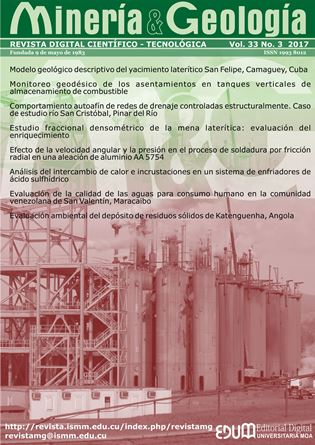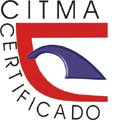Geodesic Monitoring of Settling in Vertical Fuel Tanks
Keywords:
storage tanks, monitoring, deformation, settling, load test.Abstract
The behavior of the settling in a vertical tank used for fuel storage was studied. Monitoring was conducted using the geodesic model for the geometric leveling of high accuracy category II. The original project varied during construction by replacing deep foundations with a surface one applying compaction techniques to improve soil resistance. The deformation values obtained provided valuable information on the implementation of the proposed foundation alternative depending on time and loads. The maximum settling was reported to be 132,6 mm. The displacements in the control points located in the perimeter of the tank had a distinct nature with a maximum of 44,2 mm, which caused the foundation structure to crack.Downloads
References
ACOSTA-GONZÁLEZ, L.E. 2011: Monitoreo del nivel de vulnerabilidad geotécnica en estructuras por métodos geodésicos ¨. Memorias VII Congreso Internacional Geomática. ISBN 978-959-723-01-7.
ACOSTA, L.E. & GARCÍA, J. 2007: La Geodesia en los estudios de peligro, vulnerabilidad y riesgos de desastres. Informática, XII Convención y Expo Internacional. La Habana, Cuba. http://www.bvs.hn/cu-2007/ponencias/GEO/GEO-106.pdf
API 650. 2010: Welded steel tanks for oil storage, American Petroleum Institute, Washington, D.C.
API 653. 2009: Tank Inspection, Repair, Alteration, and Reconstruction. Publicación de la American Petroleum Institute. Fourth edition. Washington, D.C.
DAS, B.M. 2008. Fundamentals of geotechnical engineering. Third edition. CL-Engineering ed.. ISBN-10: 0-495-29572-8.
DYCTA. 2005: Norma Inglesa. Diseño y Cálculo de Tanques de Almacenamiento. 130 pág.
FERNÁNDEZ, S.; JACA, R.C. & GODOY, L.A. 2011: Descenso de apoyos en el revestimiento lateral de naves industriales. Mecánica Computacional, 30: 857–874.
GEOCUBA. 2002: Informe sobre las observaciones de los asentamientos por métodos geodésicos en el Tanque de combustible 1 de la CTE de Felton.
GODOY, L.A. & SOSA, E.M. 2003: Localized support settlements of thin-walled storage tanks. Thin-Walled Structures, 41 :941-955.
HEUNECKE, O. & WELSCH, W. 2000: A Contribution to Terminology and Classification of Deformation Models in Engineering Surveys. Journal of Geospatial Engineering, 2(1) :35-44
JACA, R.C; BURGOS, C. A. & GODOY, L. A. 2013: Evaluación de fallas de tanques horizontales de almacenamiento de fluidos. Mecánica Computacional 32 :3463-3482.
MET 30-27. GEOCUBA. 2004: Metodología para el control de deformaciones de obras a partir de métodos geodésicos.
NC 1: 2007: Norma para el diseño geotécnico de cimentaciones superficiales.
RECAREY, C.A. 2000: Modelación del terreno y las estructuras en el dominio del tiempo. Memorias 4to. Simposio Internacional de Estructuras, Geotecnia y Materiales de Construcción. La Habana, Cuba.
SAVVAIDIS, P. & IFADIS I. 2001: Geodetic Monitoring of the Deformation of a 50,000 t Sugar Storage Tank Founded on 124 Long Bored Piles. Proceedings of Inter. Symp. On Geodetic, Photogrammetric and Satellite Technologies, Sofia, 160-167.
SAVVAIDIS, P. 2003: Long term geodetic monitoring of the deformation of a liquid storage tank founded on piles. Proceedings, 11th FIG Symposium on Deformation Measurements, Santorini, Greece.
USACE.EM.1110-2-1009. 2002: “U.S. Army Corps of Engineers Manual”. Structural deformation Surveying. Washington, DC 20314-1000, Junio.
Published
How to Cite
Issue
Section
Copyright (c) 2017 Luis Enrique Acosta-González, Sergio Edilio Ricardo-Desdín, Yusleydis Cano-Ricardo, Elizabeth Rivas-Freeman

This work is licensed under a Creative Commons Attribution-NonCommercial 4.0 International License.
- Authors retain copyright and guaranteeing the right magazine to be the first publication of the work as licensed under a Creative Commons Attribution-NonCommercial that allows others to share the work with an acknowledgment of the work's authorship and initial publication in this journal.
- Authors may establish separate supplemental agreements for the exclusive distribution version of the work published in the journal (eg, place it in an institutional repository or publish it in a book), with an acknowledgment of its initial publication in this journal.
- Authors are allowed and recommended to disseminate their work through the Internet (e.g., in institutional telematic archives or on their websites) before and during the submission process, which can produce interesting exchanges and increase citations of the published work. (See The effect of open access)










